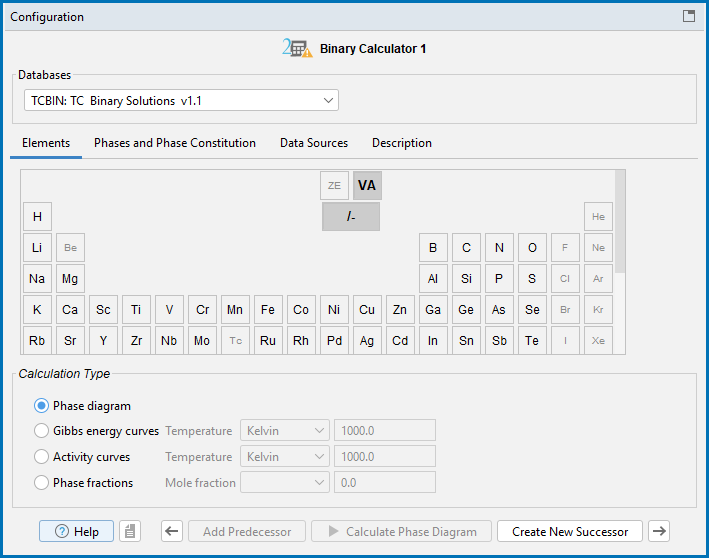Binary Calculator: Configuration Window Settings
The Binary Calculator Configuration settings window and the associated tabs are similar to what you see on a System Definer. The database TCBIN is added by default when you use the Binary template (on the  My Projects Configuration window under Equilibrium), but you can choose an installed and licensed database from the list.
My Projects Configuration window under Equilibrium), but you can choose an installed and licensed database from the list.
The various versions of the TCFE (Thermo‑Calc Steels and Fe-Alloys) databases are not compatible with the Binary Calculator.
Settings
On the Elements tab, and based on the database selected, select and review elements from the periodic table. Unavailable elements, which are based on the selected database, are greyed out.
At the top of the Phases and Phase Constitution tab, and based on the selected database, you can review the Status for the selected Phases. Select the Check/uncheck all checkbox to toggle between the options.
To review the Phase constitution for a specific phase, click it in the Phase list (for example BCC_A2) and its details are displayed below the Phases list. Click Edit then click an element to select or reject a constituent. The last remaining constituent on a sublattice cannot be rejected.
Data sources are not available until the activity is performed. Click Perform Tree at the bottom of the window to display available data sources.
The Description tab displays a description of the selected database.
Click to choose a Calculation Type.
- Phase diagram: To calculate in a defined multicomponent heterogeneous system, from one or more initial equilibria. A phase diagram is usually mapped within a specific space that is constructed by two (or more) defined independent mapping axis-variables.
- Gibbs energy curves: To calculate at a constant temperature over the whole composition range.
- Activity curves: To calculate at a constant temperature over the whole composition range.
- Phase fractions: To calculate as a function of temperature at a constant composition.
Then:
- For Gibbs energy curves and Activity curves, select a unit from the Temperature list: Kelvin, Celsius, or Fahrenheit and enter a value in the field.
- For Phase fractions, select and enter the Mole fraction component and enter a value in the field.
For the Plot Renderer, there is an option to use the  Table View button to convert plots to table data for all calculation types and calculators.
Table View button to convert plots to table data for all calculation types and calculators.
